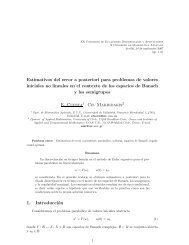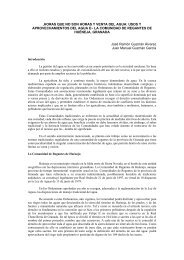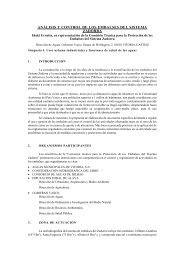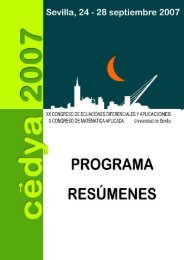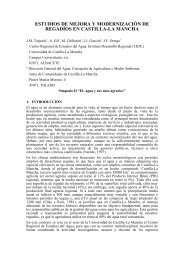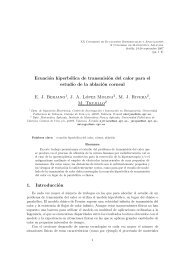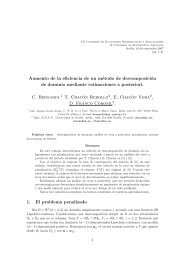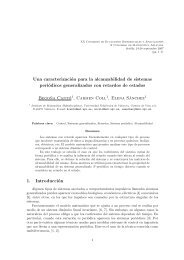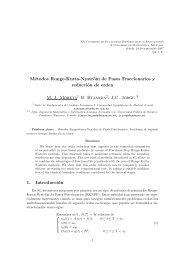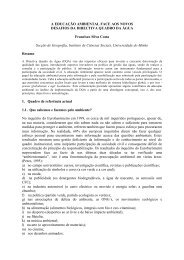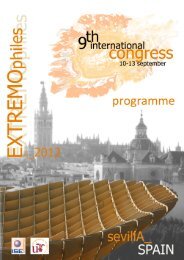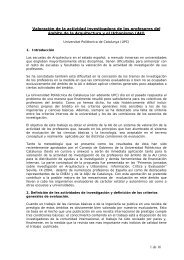LIBRO DE ACTAS (pdf) - Universidad de Sevilla
LIBRO DE ACTAS (pdf) - Universidad de Sevilla
LIBRO DE ACTAS (pdf) - Universidad de Sevilla
Create successful ePaper yourself
Turn your PDF publications into a flip-book with our unique Google optimized e-Paper software.
Automatic Detection of Melodic Patterns in Flamenco Singing by Analyzing Polyphonic Music Recordings<br />
and exp-6. The number in the name of the pattern refers to the phrase it occurs in.<br />
Figure 1: Characteristic patterns in Valver<strong>de</strong> fandango.<br />
Pattern exp-1 is composed of a turn-like figure around the tonic. Pattern exp-2 basically goes<br />
up by a perfect fifth. First, the melody insists on the B flat, makes a minor-second mor<strong>de</strong>nt-like<br />
movement, and then rises with a leap of a perfect fourth. Pattern exp-4 is a fall from the tonic to<br />
the fourth <strong>de</strong>gree by conjunct <strong>de</strong>grees followed by an ascending leap of a fourth. Pattern exp-6 is<br />
a movement from B flat to the tonic. Again, the B flat is repeated, then it goes down by a halftone<br />
and raises to the tonic with an ascending minor third. The rhythmic grouping of the<br />
melodic cell is ternary (three eighth notes for B flat and three eighth notes for A).<br />
Again, notice that this is a symbolic <strong>de</strong>scription of the actual patterns heard in the audio files.<br />
Any of these patterns un<strong>de</strong>rgo substantial in terms of duration, sometimes even in pitch, not to<br />
mention timbre and other expressive features.<br />
3.1 The Corpus of Fandango<br />
The corpus employed in our study was provi<strong>de</strong>d by Centro andaluz <strong>de</strong> flamenco <strong>de</strong> la Junta <strong>de</strong><br />
Andalucía, an official institution whose mission is the preservation of flamenco music as cultural<br />
heritage. This institution possesses around 1200 fandangos, from which only 241 were selected.<br />
Four criteria for this selection were adopted, namely: (1) Audio files should contain guitar and<br />
voice; (2) Audio files should have enough recording quality so that they could be automatically<br />
processed; (3) Fandangos should be interpreted by singers from Huelva or acknowledged singing<br />
masters; (4) Time span of the recordings should be broad, in this case it ranges from 1950 to<br />
2009.<br />
This corpus was gathered for a larger project to investigate fandango in <strong>de</strong>pth. The sample<br />
taken is broadly representative of styles and ten<strong>de</strong>ncies over time. The present paper represents<br />
the first work and, consequently, only 60 fandangos were taken, 30 Valver<strong>de</strong> fandangos and 30<br />
Huelva capital fandangos. The styles that were not used in the experiment are Valientes of<br />
Huelva fandangos, Valientes <strong>de</strong> Alosno fandangos, Calañas fandangos, and Almonaster<br />
fandangos. All pieces were extracted in wav format, monophonic audio with 16 bit-<strong>de</strong>pth and 44<br />
Khz sampling rate.<br />
4. Computational Method<br />
4.1 Audio Feature Extraction<br />
As already mentioned, written scores in flamenco music are scattered and scant. This can be<br />
explained to some extent because flamenco is music of oral transmission. The issue of what the<br />
best method to transcribe would be is quite controversial in the flamenco community. Some<br />
authors are in favour of Western notation, such as Hurtado and Hurtado [HTHT02], whereas<br />
others propose different methods, as Donnier [Don97], who advocates the use of plainchant<br />
neumes. In view of this controversy, for our work we used a more technological approach,<br />
consisting of automatic transcription through audio feature extraction.<br />
Let us <strong>de</strong>scribe how this audio feature extraction algorithm works. Our goal was to extract the<br />
vocal line in an a<strong>de</strong>quate format that at the same time was musically meaningful and could serve<br />
as input to the pattern <strong>de</strong>tection algorithm. The audio feature extraction was mainly based on<br />
predominant F0 estimation from polyphonic signals. For this, we drew upon the work of<br />
228



